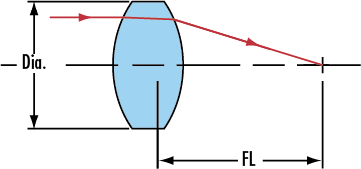
Double-convex (DCX) lenses have two outward curved surfaces, a positive focal length and are useful for 1:1 imaging and in multi-element systems.
40 - 49.9mm Experimental Quality Double-Convex (DCX) Lenses are offered in several experimental grade options. Grade 1 is standard optical glass, edged, free of visible scratches, chips, stains, or oxidation. Grade 2 is unedged, non-optical glass, small chips, slight stains, or other defects. They may have slight edge cement separation.
Note: Specifications for experimental grade optics may vary as much as 10% from those listed. Also, no additional information is available other than what is provided.

or view regional numbers
QUOTE TOOL
enter stock numbers to begin
Copyright 2023, Edmund Optics India Private Limited, #267, Greystone Building, Second Floor, 6th Cross Rd, Binnamangala, Stage 1, Indiranagar, Bengaluru, Karnataka, India 560038
California Consumer Privacy Acts (CCPA): Do Not Sell or Share My Personal Information
California Transparency in Supply Chains Act
The FUTURE Depends On Optics®